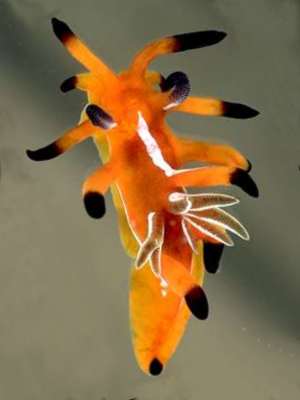
Okenia mellita
Rudman, 2004
Order: NUDIBRANCHIA
Suborder: DORIDINA
Superfamily: ANADORIDOIDEA
Family: Goniodorididae
DISTRIBUTION
Known only from eastern Australian waters.
PHOTO
Split Solitary Is, Coffs Harbour, New South Wales, Australia, February 1993, 18 mm long, AM C172896. Photo: W.B. Rudman.
The body is relatively high and there are 5 large lateral papillae along the mantle edge on each side of the body. The middle 3 on each side are the longest, about twice the width of the body. These papillae often wave around and can be held vertically or folded over the body. There is also a single long mediodorsal papilla, just in front of the gills. The gills are long and simple and arranged in 3 clusters, one in front of the anal papillae, and one on either side. The rhinophores are similar in shape and length to the dorsal papillae.
The background colour of the body is orange. The mantle papillae are all tipped with black, and there is a black tip to the oral tentacles, and a black spot on the posterior tip of the foot. There is also an opaque white line down the dorsal midline from between the rhinophores to the base of the medio-dorsal papilla just in front of the gills. The white line extends approximately halfway up the anterior face of this papilla. A white line runs along each side of the body and around the anterior end just below the lateral papilla. A branch of this line runs up the ventral, or outer, face of each papilla to just below the black tip. The rhinophore stalk is translucent orange and the club is black. A white line runs up the posterior midline of the rhinophore, partly on the stalk and partly on the club. The gills are a translucent orange with opaque white edging.
The orange colour pattern of Okenia mellita, with black-tipped papillae and white lines is quite unique in the genus. The name mellita comes from the Latin words for honey, honeyed, a reference to the golden orange-yellow colour of the animal. It is one of group of larger species in which there is no distinct ridge to differentiate the edge of the mantle. We have no information on the natural history of this species, but the strongly developed radular teeth and jaw elements, suggest this species could feed on a bryozoan with a calcified skeleton. See message #12641 for information on radula.
-
Rudman, W.B. (2004) Further species of the opisthobranch genus Okenia (Nudibranchia: Goniodorididae) from the Indo-West Pacific. Zootaxa, 695: 1-70.
Rudman, W.B., 2004 (December 21) Okenia mellita Rudman, 2004. [In] Sea Slug Forum. Australian Museum, Sydney. Available from http://www.seaslugforum.net/factsheet/okenmell
Related messages
-
Okenia mellita - new area of Ningaloo Reef
From: Kristin Anderson, April 16, 2005 -
Re: Okenia mellita from southern New South Wales
From: Leander Wiseman, January 2, 2005 -
Re: Okenia cf. mellita - Ningaloo Reef
From: Kristin Anderson, January 1, 2005 -
Okenia cf. mellita - Ningaloo Reef
From: Kristin Anderson, December 31, 2004 -
Okenia mellita from southern New South Wales [2]
From: Dave Harasti, December 22, 2004 -
Okenia mellita from southern New South Wales
From: Leander Wiseman, December 22, 2004 -
Radula of Okenia mellita
From: Bill Rudman, December 21, 2004
